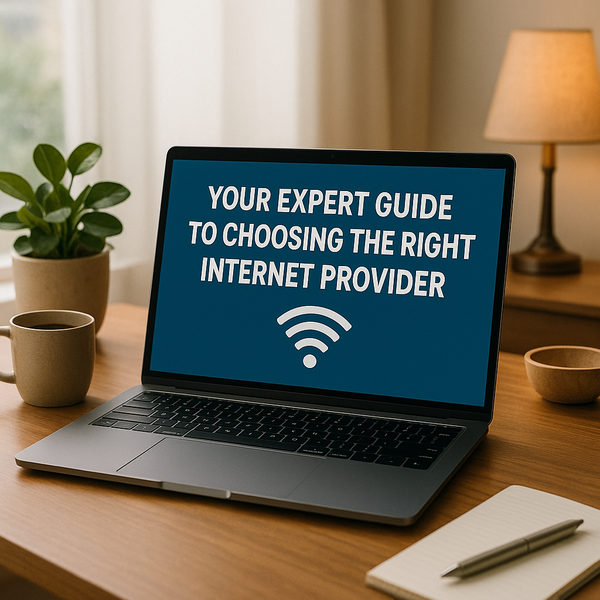
Selecting the right internet provider is a crucial decision in today's connected world. Whether you're working from home, streaming your favorite shows, gaming online, or simply browsing the web, having reliable and fast internet is essential. But with numerous options available, how do you navigate the choices and find the best fit for your household needs? This guide breaks down the key factors to consider, helping you make an informed decision.
Understanding Different Types of Internet Connections
Before comparing providers, it's vital to understand the different types of internet connections available. Each type offers distinct advantages and disadvantages regarding speed, availability, and cost. Knowing the characteristics of each will help you narrow down your search based on what's technically feasible in your area and what meets your performance requirements.
DSL (Digital Subscriber Line)
DSL internet uses existing telephone lines to transmit data. It's often more widely available than newer technologies, particularly in rural areas. Speeds can vary significantly based on your distance from the provider's central office. While generally slower than cable or fiber, it can be adequate for basic browsing, email, and light streaming for smaller households. DSL is typically an 'always on' connection, unlike older dial-up services.
Cable Internet
Cable internet utilizes the coaxial cables originally installed for cable television service. It's one of the most common types of internet in urban and suburban areas, known for offering higher speeds than DSL. Speeds can fluctuate depending on network congestion in your neighborhood, as the bandwidth is shared among users. Cable is suitable for households with multiple devices, streaming in HD, and online gaming.
Fiber Optic Internet
Fiber optic internet is the fastest type of internet connection currently available to consumers. It uses strands of glass or plastic fibers to transmit data using light signals, offering symmetrical speeds (upload and download speeds are often the same or very similar). Fiber provides exceptional performance, making it ideal for heavy data users, large households, 4K streaming, competitive online gaming, and frequent large file uploads. Availability is still growing, primarily found in densely populated areas.
Satellite Internet
Satellite internet is transmitted via satellites orbiting Earth, making it available in almost any location, including very remote areas where other types of internet are unavailable. However, it typically has slower speeds, lower data caps, and higher latency (delay) compared to wired connections. Latency can impact real-time applications like online gaming and video conferencing. It's often a last resort for areas with no other options.
Fixed Wireless Internet
Fixed wireless internet transmits data wirelessly from a central hub (like a tower) to a receiver antenna installed at your home. It's a viable option in areas where wired infrastructure is limited. Performance can be affected by distance, obstructions (like trees or buildings), and weather conditions. Speeds are generally better than satellite but vary greatly depending on the provider's technology and your location relative to the tower.
Assessing Your Internet Speed Needs
The required internet speed depends entirely on how you use the internet and the number of people and devices in your household. A single person occasionally checking email and browsing needs much less speed than a family of five who stream simultaneously on multiple devices, game online, and work from home. Consider activities like streaming video (SD, HD, 4K), online gaming, video conferencing, downloading large files, and the number of connected devices (smartphones, tablets, laptops, smart TVs, smart home devices). Most providers list plans based on download speed (Mbps - megabits per second), but upload speed is also important for video calls and sending large files.
Checking Provider Availability in Your Area
Not all types of internet or providers are available everywhere. The first step in choosing a provider is to determine which ones actually serve your specific address. Most provider websites have an availability checker tool where you can enter your street address to see the services offered. It's wise to check multiple providers to see all the options accessible to you.
Comparing Internet Plans and Packages
Once you know which providers serve your location, compare their available plans. Look beyond just the advertised speed. Consider data caps (some plans limit how much data you can use per month), contract terms (many require a 1 or 2-year commitment, often with early termination fees), equipment costs (modem/router rental or purchase), installation fees, and any promotional pricing that might expire after an initial period, leading to a price increase.
Evaluating Customer Service and Reputation
Reliable internet is important, but so is getting help when something goes wrong. Research providers' customer service reputation. Look for online reviews, ask neighbors, or check consumer reports. Factors like ease of contacting support, technical expertise, and response times are worth considering.
Bundle Options
Many internet providers also offer services like TV and phone. Bundling these services can sometimes result in cost savings compared to subscribing to them individually from different companies. However, ensure the bundle truly meets your needs and the overall cost is competitive after any promotional periods end.
Understanding the Total Cost
When comparing costs, don't just look at the monthly service fee. Factor in all potential charges: monthly equipment rental fees, installation fees, activation fees, and taxes. Understand what the price will be after any introductory period expires.
Choosing an internet provider involves carefully evaluating your needs, researching available options, understanding the different connection types, and comparing plans based on speed, data caps, contract terms, and overall cost. By following these steps, you can find a provider and plan that offers the performance and reliability you need for your connected lifestyle, ensuring a smooth online experience for everyone in your home.

